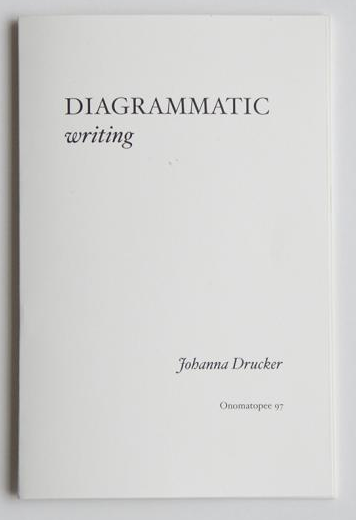Johanna Drucker: Diagrammatic Writing (2013)
Filed under artist publishing | Tags: · book, diagram, gestalt theory, graphic design, text, writing

“This is a book that is as close as possible to being entirely about itself.”
Diagrammatic Writing is a poetic demonstration of the capacity of format to produce meaning. The articulation of the codex, as a space of semantically generative relations, has rarely (if ever) been subject to so highly focused and detailed a study. The text and graphical presentation are fully integrated, co-dependent, and mutually self-reflexive.
This small book work should be of interest to writers, bibliographers, designers, conceptual artists, and anyone interested in the meta-language of diagrammatic thought in graphic form.
Edited, written and designed by Johanna Drucker
Online edition: /ubu editions, Visual Writing series
Printed edition: Onomatopee, Eindhoven; Cabinet Project, 97
Creative Commons BY-NC License
32 pages
via UbuWeb
Commentary: Johanna Drucker (New Formations, 2013), Johanna Drucker (Iowa Review, 2014).
PDF (updated on 2018-12-31)
Comment (0)Libre Graphics magazine 2(2): Gendering F/LOSS (2014)
Filed under magazine | Tags: · floss, free culture, free software, gender, graphic design, libre graphics, software

The current issue of Libre Graphics engages with discussions around representation and gendered work in Free/Libre Open Source Software and Free Culture.
Why Gendering F/LOSS? In the world of F/LOSS, and in the larger world of technology, debate rages over the under-representation of women and the frat house attitude occasionally adopted by developers. The conventional family lives of female tech executives are held up as positive examples of progress in the battle for gender equity. Conversely, pop-cultural representations of male developers are evolving, from socially awkward, pocket-protectored nerds to cosmopolitan geek chic. Both images mask the diversity of styles and gender presentations found in the world of F/LOSS and the larger tech ecology. Those images also mask important discussions about bigger issues: is it okay to construct such a strict dichotomy between “man” and “woman” as concepts; how much is our work still divided along traditional gender lines; is it actually enough to get more women involved in F/LOSS generally, or do we need to push for specific kinds of involvement; do we stop at women, or do we push for a more inclusive understanding of representation?
This issue looks at some of the thornier aspects of gender in F/LOSS art and design. In discussing gendered work, the push for greater and greater inclusion in our communities, and representations of gender in our artistic practices, among others, we hope to add and amplify voices in the discussion.
Edited by Ana Isabel Carvalho, ginger coons and Ricardo Lafuente
Publisher ginger coons, January 2014
Creative Commons Attribution-Share Alike license
ISSN 1925-1416
56 pages
PDF (31 MB, low-res version for screen)
PDF (360 MB, high-res version for print)
Gerd Arntz, Otto Neurath, et al.: Gesellschaft und Wirtschaft: Bildstatistisches Elementarwerk (1930) [German]
Filed under book | Tags: · data visualisation, economy, graphic design, infographics, society, statistics

Economy and Society: Elementary Pictorial Statistics is an early example of socially-engaged piece of graphic design. The work was commissioned by the Bibliographical Institute in Leipzig, an important publisher of reference works and dictionaries, to the political economist and Vienna Circle philosopher Otto Neurath and his initiative, the Museum of Society and Economy.
The city-funded Museum was conceived as an institution for informing the public about the results of sociological and economical research. It staffed Marie Reidemeister, the University of Göttingen educated mathematician, Josef Jodlbauer and others. Since 1928 they also worked with graphic artist and council communist Gerd Arntz. The team developed their own method of visual education, picture statistics, hoping to ensure that even “passers-by [..] can acquaint themselves with the latest sociological and economical facts at a glance,” and later to become known as Isotype.
Economy and Society was made as a collection of one hundred statistical charts printed on loose leaves, depicting the state of world affairs of their day, with thirty text tables of source statistics included in an appendix.
“Isotype was conceived as a picture language for teaching purposes and as a lingua franca, not a universal code. Its signs were constructed as clearly as possible in themselves, so they could be used without the help of words. The signs were arranged into ‘fact pictures’ according to certain rules, which were set up by a ‘chief organization’ – as Neurath called his workrooms at The Hague. Thus a picture language emerged from the consistent use of expert graphic design. Its elements or pictograms were reduced to the smallest possible detail of what they represented, for example starting with the outline of a ‘man’, and if necessary, adding attributes to identify the man as a ‘worker’, a ‘coal miner’ or an ‘unemployed person’, and so on. Perspective was abandoned in the pictures, illustrating details were banned and any use of colors would be standardized. Starting with Gesellschaft und Wirtschaft, the picture books produced show the struggle to build up a visual system of rules and signs. As its goal, Neurath identified the ‘education of public opinion’ and, on the utopian level, access to knowledge for all: ‘The Isotype picture language would be of use as a helping language in an international encyclopaedia of common knowledge’.” (this paragraph is taken from Frank Hartmann, Humanization of Knowledge Through the Eye, 2005)
Elementarwerk. Das Gesellschafts- und Wirtschaftsmuseum in Wien zeigt in 100 farbigen Bildtafeln Produktionsformen, Gesellschaftsordnungen, Kulturstufen, Lebenshaltungen
Publisher Bibliographisches Institut, Leipzig, 1930
130 leaves
via Libcom.org
Commentaries: Nader Vossoughian (2003), Sybilla Nikolow (2006), Ed Annink and Max Bruinsma (n.d.), Robin Kinross (2008).
PDF (15 MB)
See also International Picture Language: The First Rules of Isotype, 1936
Comment (0)

